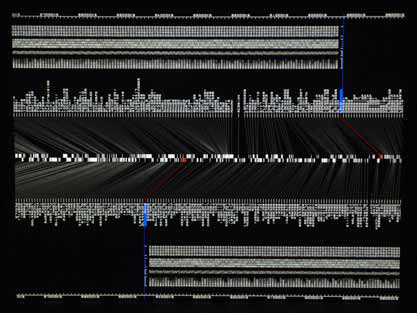Datamatics [ver 2.0]: Audio-visual Immersion

Parisian artist Ryoji Ikeda presented Datamatics [ver 2.0] as part of the PuSh Festival on Feb 3, 2011. This audio-visual concert was presented on a large screen the Djavad Mowafaghian Cinema at SFU Woodwards.
Providing both sensory immersion and a cerebral experience, this is a work that operates beyond easy binaries even though it is built from oppositions. Visually, the piece explores “pure data” -- back and white imagery generated from sources as diverse as computer malfunctions, star-mapping systems, and human genome mapping procedures In at artist's talk the following evening, the soft-spoken Ikeda said “scientists get my work right away – and they say it looks beautiful, but it doesn't mean anything.” From Ikeda's point of view this is all to the good: he uses information as the palette from which he creates a sensory experience. Fascinated by black and white, binary information, sine waves and white noise, the presence and absence of sound, he sees the numerals and geometry he puts on the screen as a movable feast generated from information, rather then as a commentary on the data itself: “I leave interpretation to the critics – that is their job” he says.
Ikeda comes to visual and media arts from the world of sound. He started his arts career as a DJ but quickly became enamoured with the idea of creating complex webs of sound that operate at a barely tolerable volume. Today he is considered an electronic composer and a visual /installation artist of some renown. Commenting on an early sound piece called “Formula,” he says “I was a young man then, and I wanted massive sound. Feedback from that piece destroyed the computer.” Datamatics [ver 2.0] arguably represents a mellowing of Ikeda's work in his middle years. Ushers handed out earplugs to audience members at the doors to the cinema, and they were much needed. The soundscape of the work is build from a gorgeous array of technological debris: electronic pulses, rapid break-beat rhythms, and fuzzy static pops combine and recombine into an intricate textured web, submerging the audience in a tumultuous ocean of sound.
Running at 65 minutes, Datamatics [ver 2.0] builds to a crescendo that is probably as near to the infamous sonic torture techniques of Guantanamo Bay as any civilian ever wishes to come. Yet in the midst of this sensory overload, audience members remained transfixed by the patterns on screen and the waves of sound washing over them.
For myself, the most interesting elements of the work were in it's “second act” -- where a 4-D grid filled with snowy points was animated by moving cross-hairs. Each time the cross intersected, a name flashed across the screen “Alpha Centuri” or “Epsilon 5.” Eventually I (and fellow audience members) realized that we were watching a star map take shape, at rapid, nearly unintelligible speeds.
The barely legible quality of information flashing on the screen, and the thunderous, thought-suppressing sound are hallmarks of Ikeda's work. He makes a conscious decision to take information that is authentic – familiar, drawn from the “real” of hard fact – and presents it in a manner that makes it not inherently informative, but part of the warp and woof of a larger aesthetic experience.
Coming away from this performance I was strangely moved: I felt I had been given the chance to look at humanity wholly as a thinking being, an odd species whose mathematical calculations have allowed us to peer into the solar system itself.
While the information that Ikeda presents is decontextualized and aestheticized, it is nonetheless intricately woven. His fascination with “pure” information is also a chance for the viewer to reflect on the invisible knowledge that flows through the world around us, creating the content and foundations of all our (by now barely remarkable) tools. Watching
Datamatics [ver 2.0] I felt a renewed understanding magnitude of the technological present in which we live.



